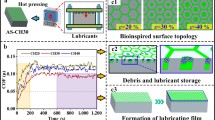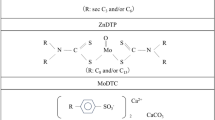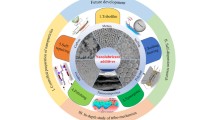Abstract
Copper and iron are the major ingredients in friction materials, among which Fe often been served as friction reinforcement in the past. But in our recent study, the coefficients of friction (COF) decreased with increasing iron content in composites. In order to study the influence of Cu/Fe ratio on the tribological behavior of the composite under simulative braking conditions, a subscale testing apparatus with the pad-on-disk configuration under various initial braking speeds (IBS) was applied. The changes in mean COFs, wear rates, morphologies and chemical constitutions of friction surface for different composites were investigated. Results showed that the composite containing more Fe content always showed lower mean COF and wear rate, which different from the previous studies. This is because, under severe braking conditions, the tribological behavior of composite mainly depends on the evolution of tribo-oxide film on the surface, not just on the substrate themselves. Higher Fe content accelerated the formation of tribo-oxide film and in turn inhibited the destruction of tribo-oxide film on the surface, which leading to lower mean COF and wear rate, as well as a higher critical IBS for the transition of mean COF and wear rate. This work also provides a way to characterize the fracture strength of tribo-film by carried out a peeling test.











Similar content being viewed by others
References
Kang, S.: A study of friction and wear characteristics of copper- and iron-based sintered materials. Wear 162–164, 1123 (1993)
Su, L., Gao, F., Han, X., Fu, R., Zhang, E.: Tribological behavior of copper–graphite powder third body on copper-based friction materials. Tribol. Lett. 60, 30 (2015)
Prabhu, T.R., Varma, V.K., Vedantam, S.: Effect of reinforcement type, size, and volume fraction on the tribological behavior of Fe matrix composites at high sliding speed conditions. Wear 309, 247 (2014)
Li, G., Yan, Q.: Comparison of friction and wear behavior between C/C, C/C-SiC and metallic composite materials. Tribol. Lett. 60, 15 (2015)
Yun, R., Filip, P., Lu, Y.: Performance and evaluation of eco-friendly brake friction materials. Tribol. Int. 43, 2010 (2010)
Xiong, X., Chen, J., Yao, P., Li, S., Huang, B.: Friction and wear behaviors and mechanisms of Fe and SiO2 in Cu-based P/M friction materials. Wear 262, 1182 (2007)
Chen, B., Bi, Q., Yang, J., Xia, Y., Hao, J.: Tribological properties of solid lubricants (graphite, h-BN) for Cu-based P/M friction composites. Tribol. Int. 41, 1145 (2008)
Winkelmann, H., Varga, M., Badisch, E.: Influence of secondary precipitations in Fe-based mmcs on high temperature wear behaviour. Tribol. Lett. 43, 229 (2011)
Cui, G., Lu, L., Wu, J., Liu, Y., Gao, G.: Microstructure and tribological properties of Fe–Cr matrix self-lubricating composites against Si3N4 at high temperature. J. Alloys Compd. 611, 235 (2014)
Jang, H., Ko, K., Kim, S.J., Basch, R.H., Fash, J.W.: The effect of metal fibers on the friction performance of automotive brake friction materials. Wear 256, 406 (2004)
Su, L., Gao, F., Han, X., Chen, J.: Effect of copper powder third body on tribological property of copper-based friction materials. Tribol. Int. 90, 420 (2015)
Li, J., Yin, Y., Ma, H.: Preparation and properties of Fe3Al-based friction materials. Tribol. Int. 38, 159 (2005)
Verma, P.C., Ciudin, R., Bonfanti, A., Aswath, P., Straffelini, G., Gialanella, S.: Role of the friction layer in the high-temperature pin-on-disc study of a brake material. Wear 346–347, 56 (2016)
Tjong, S.C., Lau, K.C.: Tribological behaviour of SiC particle–reinforced copper matrix composites. Mater. Lett. 43, 274 (2000)
Österle, W., Urban, I.: Friction layers and friction films on PMC brake pads. Wear 257, 215 (2004)
Blau, P.J.: Elevated-temperature tribology of metallic materials. Tribol. Int. 43, 1203 (2010)
Kato, H., Komai, K.: Tribofilm formation and mild wear by tribo-sintering of nanometer-sized oxide particles on rubbing steel surfaces. Wear 262, 36 (2007)
Jiang, J., Stott, F.H., Stack, M.M.: The role of triboparticles in dry sliding wear. Tribol. Int. 31, 245 (1998)
Godet, M.: The third-body approach: a mechanical view of wear. Wear 100, 437 (1984)
Desplanques, Y., Degallaix, G.: Genesis of the third-body at the pad-disc interface: case study of sintered metal matrix composite lining material. SAE Int. J. Mater. Manuf. 2, 25 (2010)
Haddad, H., Guessasma, M., Fortin, J.: A DEM–FEM coupling based approach simulating thermomechanical behaviour of frictional bodies with interface layer. Int. J. Solids Struct. 81, 203 (2016)
Jacko, M.G., Tsang, P.H.S., Rhee, S.K.: Wear debris compaction and friction film formation of polymer composites. Wear 133, 23 (1989)
Österle, W., Dörfel, I., Prietzel, C., Rooch, H., Cristol-Bulthé, A.L., Degallaix, G., Desplanques, Y.: A comprehensive microscopic study of third body formation at the interface between a brake pad and brake disc during the final stage of a pin-on-disc test. Wear 267, 781 (2009)
Peng, T., Yan, Q., Li, G., Zhang, X., Wen, Z., Jin, X.: The braking behaviors of Cu-based metallic brake pad for high-speed train under different initial braking speed. Tribol. Lett. (2017). https://doi.org/10.1007/s11249-017-0914-9
Huang, Z., Zhai, H., Guan, M., Liu, X., Ai, M., Zhou, Y.: Oxide-film-dependent tribological behaviors of Ti3SiC2. Wear 262, 1079 (2007)
Desplanques, Y., Degallaix, G.: Interactions between third-body flows and localisation phenomena during railway high-energy stop braking. SAE Int. J. Passeng. Cars Mech. Syst. 1, 1267 (2008)
Hou, P.Y., Priimak, K.: Interfacial segregation, pore formation, and scale adhesion on NiAl alloys. Oxid. Met. 63, 113 (2005)
Wu, T., Tong, J., Hsieh, J.J., Yang, Y.S.: Improvement of interfacial adhesion of Al/Cr films deposited on indium tin oxide coated glasses by interfacial oxidation. Surf. Coat. Technol. 183, 89 (2004)
Adachi, K., Koji, K.: Formation of smooth wear surfaces on alumina ceramics by embedding and tribo-sintering of fine wear particles. Wear 245, 84 (2000)
Kato, H.: Effects of supply of fine oxide particles onto rubbing steel surfaces on severe-mild wear transition and oxide film formation. Tribol. Int. 41, 735 (2008)
Quinn, T., Sullivan, J., Rowson, M.: Origins and development of oxidational wear at low ambient temperatures. Wear 94, 175 (1984)
So, H., Yu, D.S., Chuang, C.Y.: Formation and wear mechanism of tribo-oxides and the regime of oxidational wear of steel. Wear 253, 1004 (2002)
Garbar, I.I.: Gradation of oxidational wear of metals. Tribol. Int. 35, 749 (2002)
Rigney, D.A., Hirth, J.P.: Plastic deformation and sliding friction of metals. Wear 53, 345 (1979)
Mcneill, L.S., Edwards, M.: The importance of temperature in assessing iron pipe corrosion in water distribution systems. Environ. Monit. Assess. 77, 229 (2002)
Rakhshani, A.E.: Preparation, Characteristics and photovoltaic properties of cuprous oxide—a review. Solid State Electron. 29, 7 (1986)
Acknowledgements
Financial support from the National Natural Science Foundation of China under Contract No. 51572026 is gratefully acknowledged.
Author information
Authors and Affiliations
Corresponding author
Rights and permissions
About this article
Cite this article
Peng, T., Yan, Q., Li, G. et al. The Influence of Cu/Fe Ratio on the Tribological Behavior of Brake Friction Materials. Tribol Lett 66, 18 (2018). https://doi.org/10.1007/s11249-017-0961-2
Received:
Accepted:
Published:
DOI: https://doi.org/10.1007/s11249-017-0961-2




